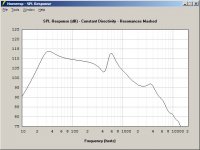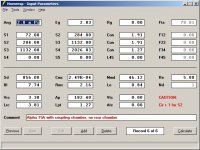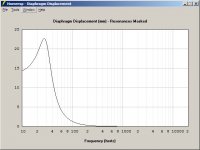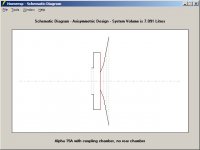Anybody out there who knows how the " Aperture Bass Propagation technology" works, mentioned here:
http://www.emeraldphysics.com/2011/01/cs23.html
http://www.emeraldphysics.com/2011/01/cs23.html
Last edited:
Based on the pic, it looks like they're doing one of two things:
- There's a chamber in front of the woofer now. A chamber would roll off the highs physically. Basically a bandpass, but tuned differently.
- Or it's a 'real' dual reflex bandpass, with a vented front and rear chamber. This is something I've really wanted to explore using Akabak or Martin King's Quarter-Wave software. You can modify the directivity of a speaker using a vent, because the vent's aperture is smaller than the speaker.
Judged by the size of this hole in front of the woofers, it should have no effect at all in the passband of the woofer.
The "Aperture Bass Propagation technology" works by impressing the customer with fancy words and by this raising the amount of money he will spend for the speaker. In its own way, this is an impressive technology. 😉
The "Aperture Bass Propagation technology" works by impressing the customer with fancy words and by this raising the amount of money he will spend for the speaker. In its own way, this is an impressive technology. 😉
I know so much that it works as a dipole, no rear chamber.
I've done some simulating in Lspcad, as a dipole radiator on rear side of cone and a small box, 4 liters, with a short, 30mm port with 100 mm diam. on the front side of the cone. The simulated results can make a grown man cry......
I've done some simulating in Lspcad, as a dipole radiator on rear side of cone and a small box, 4 liters, with a short, 30mm port with 100 mm diam. on the front side of the cone. The simulated results can make a grown man cry......
MaVo said:Judged by the size of this hole in front of the woofers, it should have no effect at all in the passband of the woofer.
The "Aperture Bass Propagation technology" works by impressing the customer with fancy words and by this raising the amount of money he will spend for the speaker. In its own way, this is an impressive technology. 😉
I've heard their previous products, they're very good. Lots of solid engineering at Emerald Physics.
A fifteen inch woofer's directivity will begin to narrow at 900hz, due to the diaphragms dimensions. My Summas take advantage of this to cross over to a waveguide which goes down to... you guessed it, 900hz.
By re-directing the energy of the fifteen inch woofer through a 6" port, the woofer will now begin to narrow at 2250khz. This change in the directivity allows the woofer to have a more consistent coverage pattern below AND above the crossover point.
Pretty clever I'd say.
I'm at work and can't sim this now. It seems to be the same as a slot loaded box without the box. Could be modelled in Horn response with no rear chamber, front chamber same as speaker volume on inside of cone and surround and a conical horn with maybe 25mm length and no expansion. Might look good until combined response is done for back to front cancellation. I have been looking at slot loading an open baffle myself to keep the directivity higher. As I said, can sometimes look good until the cancellation comes into the sim.
jamikl
jamikl
Patrick Bateman said:By re-directing the energy of the fifteen inch woofer through a 6" port, the woofer will now begin to narrow at 2250khz. This change in the directivity allows the woofer to have a more consistent coverage pattern below AND above the crossover point.
Pretty clever I'd say.
You have to take into account that this box uses a 12 inch coaxial driver for mid, so the crossover point will be probably 3 octaves below this 2250hz and thats why the holes wont have much effect.
MaVo said:
The "Aperture Bass Propagation technology" works by impressing the customer with fancy words and by this raising the amount of money he will spend for the speaker. In its own way, this is an impressive technology. 😉
Thats my take on it too.
jamikl said:I'm at work and can't sim this now. It seems to be the same as a slot loaded box without the box. Could be modelled in Horn response with no rear chamber, front chamber same as speaker volume on inside of cone and surround and a conical horn with maybe 25mm length and no expansion. Might look good until combined response is done for back to front cancellation. I have been looking at slot loading an open baffle myself to keep the directivity higher. As I said, can sometimes look good until the cancellation comes into the sim.
jamikl
In some ways, it reminds me of a u-frame woofer as well. That was probably one of the most satisfying projects I've worked on. Easy to build, highly efficient, and sound great.
MaVo said:
You have to take into account that this box uses a 12 inch coaxial driver for mid, so the crossover point will be probably 3 octaves below this 2250hz and thats why the holes wont have much effect.
If that's the case, then my first guess, in post #2 makes sense.
The designer is using a chamber in front of the woofer to roll off the highs, just like a bandpass box.
That's quite clever I think - he's getting the dipole radiation pattern of a dipole, along with the distortion-filtering aspects of a bandpass.
Let's do the math real quick, to see if my hunch is valid.
To figure out the tuning frequency of the chamber, we use this formula:
(2 * fs) / qes
for an Eminence Alpha 15A, that's (82 hz / 1.53 ) = 53.59hz
http://www.parts-express.com/pe/showdetl.cfm?Partnumber=290-407
And then you tune the backchamber to that frequency.
But there IS NO backchamber. So the Fb of the backchamber is the same as the Fs of the woofer which is...
41hz.
So yeah, looks like this would work. The Fb is off by a third of an octave, but that won't make much of a difference.
FYI, The specs say the woofers to mid crossover is at 100hz (LR8-DSP active) and the mid to tweet is at 900hz (BW3-passive).
>>> The "Aperture Bass Propagation technology" works by impressing the customer with fancy words and by this raising the amount of money he will spend for the speaker. In its own way, this is an impressive technology.
LOL... i don't see where the other driver is?
Godzilla
LOL... i don't see where the other driver is?
Godzilla
jamikl said:I'm at work and can't sim this now. It seems to be the same as a slot loaded box without the box. Could be modelled in Horn response with no rear chamber, front chamber same as speaker volume on inside of cone and surround and a conical horn with maybe 25mm length and no expansion. Might look good until combined response is done for back to front cancellation. I have been looking at slot loading an open baffle myself to keep the directivity higher. As I said, can sometimes look good until the cancellation comes into the sim.
jamikl
I modeled it a different way. I modeled it as if the enclosure was backwards. So there's a ported *rear* chamber, with a six inch port that's one half inch deep. (We don't know the depth, but we can guess.) The volume under the cone should be about 3.3liters. Again, we can only guess. Reducing the volume will change the tuning frequency of the bandpass.
Here's the modeled frequency response.
Attachments
jamikl said:I'm at work and can't sim this now. It seems to be the same as a slot loaded box without the box. Could be modelled in Horn response with no rear chamber, front chamber same as speaker volume on inside of cone and surround and a conical horn with maybe 25mm length and no expansion. Might look good until combined response is done for back to front cancellation. I have been looking at slot loading an open baffle myself to keep the directivity higher. As I said, can sometimes look good until the cancellation comes into the sim.
jamikl
Here's the parameters I used. Note that the "horn" is actually the cone of the woofer itself. It has a diamter of fifteen inches and a depth of 1.5". I also added a baffle that's 20" wide.
Attachments
MaVo said:
You have to take into account that this box uses a 12 inch coaxial driver for mid, so the crossover point will be probably 3 octaves below this 2250hz and thats why the holes wont have much effect.
I don't know why I didn't think about the obvious reason to use a bandpass chamber in a dipole.
It reduces the excursion!
duh, how did I miss that?
So you tune the front chamber carefully, and you can double or quadruple the power handling, by reducing the excursion.
Attachments
Patrick Bateman said:
I don't know why I didn't think about the obvious reason to use a bandpass chamber in a dipole.
It reduces the excursion!
duh, how did I miss that?
So you tune the front chamber carefully, and you can double or quadruple the power handling, by reducing the excursion.
Hey John
I don't follow the cone excursion reduction. With a 100 Hz LP there will be no effect to the excursion below 100 Hz.
gedlee said:
Hey John
I don't follow the cone excursion reduction. With a 100 Hz LP there will be no effect to the excursion below 100 Hz.
There's a 48db/octave electronic filter at 100hz.
But the coupling chamber in front of the woofer forms a physical lowpass. If they tuned it at ((2 * FS) / qes), then the reduction in excursion would occur at 53.59hz.
So that seems quite clever. You get a reduction in excursion at the tuning frequency, a reduction in 2nd and 3rd harmonic distortion, and a dipole radiation patterns.
If you're into dipoles, this seems like a serious improvement.
- Status
- Not open for further replies.
- Home
- Loudspeakers
- Multi-Way
- Emerald Physics



